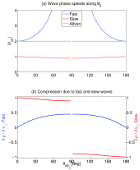 The group of Solar and Heliospheric Physics has published a research paper on Ann. Geophys., focusing on how to identify slow magnetosonic waves in MHD turbulence. A new criteria is proposed in this paper. The advantage of this criteria lies in its insensitiveness to the propagation angle, which is not easy to estimate in the 3D simulation data. Therefore, the method of this work can be applied to the identification and statistical analysis of the compressive waves in 3D turbulence. The authors also qualitatively describe the physical feature and temporal evolution of four events of slow mode waves as identified.
The group of Solar and Heliospheric Physics has published a research paper on Ann. Geophys., focusing on how to identify slow magnetosonic waves in MHD turbulence. A new criteria is proposed in this paper. The advantage of this criteria lies in its insensitiveness to the propagation angle, which is not easy to estimate in the 3D simulation data. Therefore, the method of this work can be applied to the identification and statistical analysis of the compressive waves in 3D turbulence. The authors also qualitatively describe the physical feature and temporal evolution of four events of slow mode waves as identified.
For details please refer to dx.doi.org/10.5194/angeo-33-13-2015.